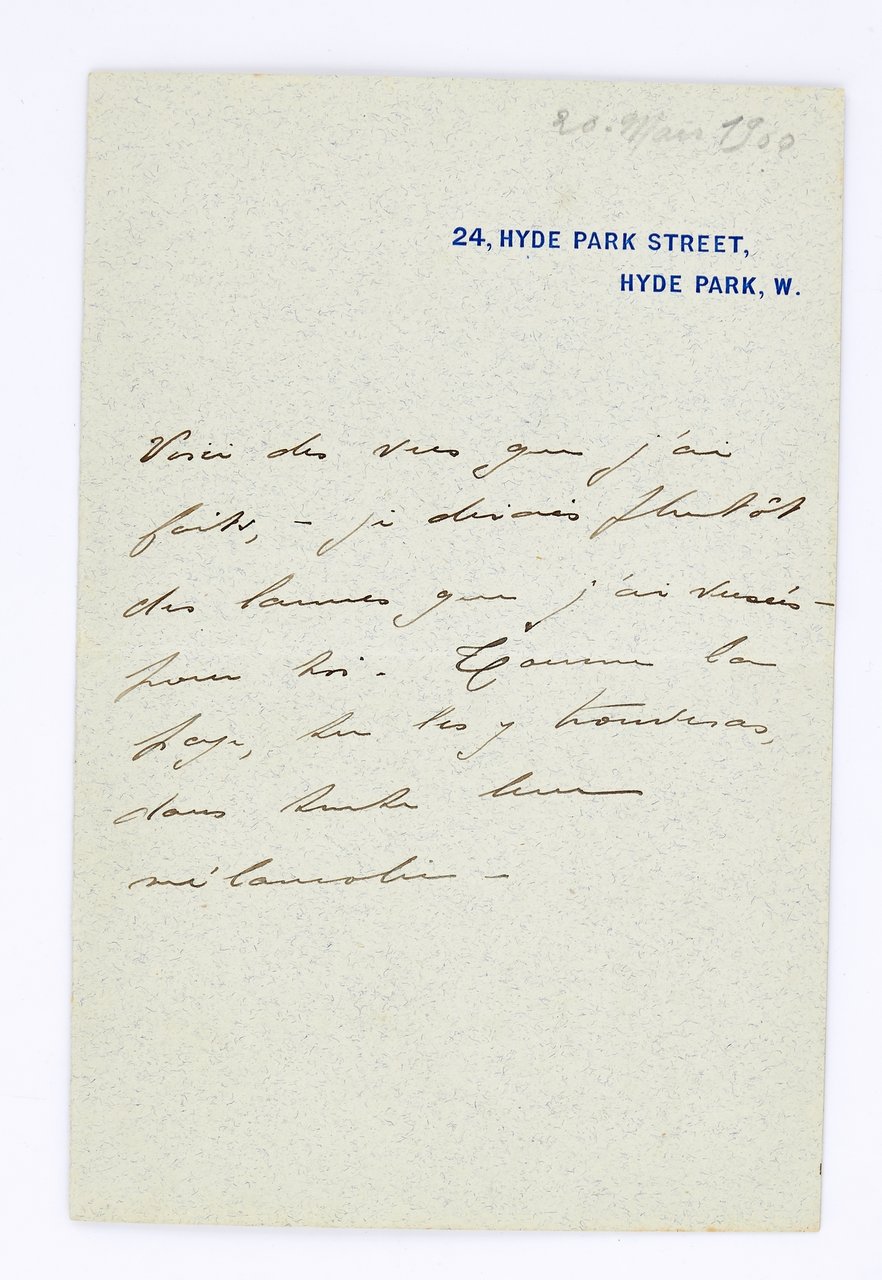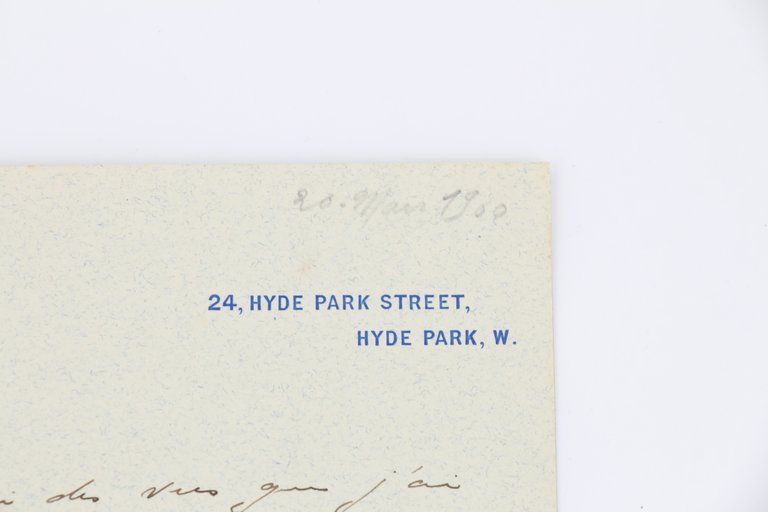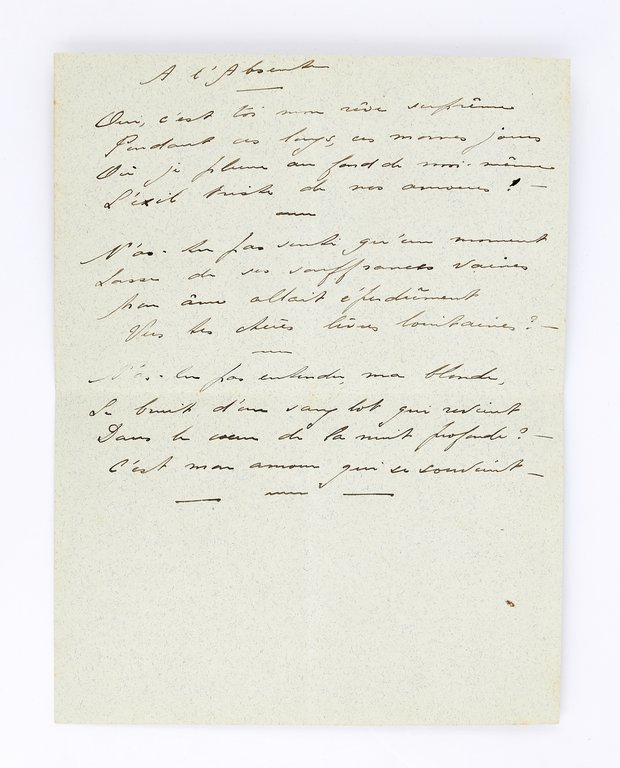s. l. 20 mars 1900 | 10 x 15.70 cm | 2 pages sur un double feuillet | Unpublished handwritten poem to Natalie Clifford Barney « à l'absente » 20 March 1900 | 10 x 15,7 cm | 2 pages on a double leaf Handwritten poem entitled « à l'absente » (“To the absent one”) and addressed to Natalie Clifford Barney. Two pages written in black ink on a double leaf, headed 24 Hyde Park Street. To our knowledge, this three-verse, octosyllabic poem is unpublished. It is preceded, on the first section of this double leaf, by a little handwritten message: “These are the verses I have made, – I would rather say the tears which I have shed – for you. Turn the page, you will find them there, in all their melancholy.” Oui, c'est toi mon rêve suprême Pendant ces longs, ces mornes jours Où je pleure au fond de moi-même L'exil triste de mes amours! [.] N'as-tu pas entendu, ma blonde, Le bruit d'un sanglot qui revient Dans le cœur de la nuit profonde ? C'est mon amour qui se souvient. It is at the end of 1899 and through Violette Shillito that Renée Vivien – then Pauline Tarn – met Natalie Clifford Barney this American woman softer than a scarf, whose sparkling face shines with golden hair, sea blue eyes, never-ending teeth (Colette, Claudine à Paris). Natalie, who had just experienced a summer romance with the scandalous Liane de Pougy who introduced her to sapphism, paid little attention to this new acquaintance. Renée, on the other hand, was totally captivated by the young American woman and describes this love at first sight in her autobiographical novel, Une femme m'apparut: I lived again the hour, already well past, when I saw her for the first time, felt the shiver that ran through me when my eyes met the mortal steel of her look, those eyes blue and piercing as a blade. I had a dim premonition that this woman would determine the pattern of my fate, and that her face was the predestined face of my Future. Near her I felt the luminous dizziness which comes at the edge of an abyss, or the attraction of a very deep water. She radiated the charm of danger, which drew me to her inexorably. Winter 1899-1900. Beginnings of the idyll. One evening, Vivien is invited by her new friend to Mme Barney's studio [Natalie's mother], 153 avenue Victor-Hugo, on the corner of the rue de Longchamp. Natalie finds the courage to read the verses of her composition. As Vivien tells her to love these verses, she tells her that it is better to love the poet. A response worthy of the Amazon. (J.-P. Goujon, Tes blessures sont plus douces que leurs caresses) Two years of unequal happiness will follow, punctuated by Natalie's recurring infidelities and Renée's sickly jealousy, the letters of which oscillate between inflamed declarations and painful admissions of guilt. Renée Vivien is the daughter of Sappho and Baudelaire, she is the 1900 flower of evil with fevers, broken-up fights, sad delights. (Jean Chalon, Portrait d'une séductrice) In 1901, a major break-up occurred which lasted almost two years; Renée, despite requests from Natalie and the others she sent to win her back, resisted. The two friends saw each other again, and in August 1905, went on a pilgrimage to Lesbos, which was a disappointment for Natalie Barney and was short-lived. [.] The spring was broken once and for all. The two former friends stopped seeing each other in 1907, and Vivien died without them seeing each other again. (J.-P. Goujon, ibid.) * [FRENCH VERSION FOLLOWS] | Poème autographe intitulé A l'absente et adressé à Natalie Clifford Barney. Deux pages rédigées à l'encre noire sur un double feuillet à en-tête du 24 Hyde Park Street. Ce poème de trois strophes en octosyllabes est à notre connaissance inédit. Il est précédé, sur le premier volet de ce double feuillet, d'un petit message manuscrit : Voici des vers que j'ai faits, - je dirais plutôt des larmes que j'ai versées - pour toi. Tourne la page, tu les y trouveras, dans toute leur mélancolie. Oui, c'est toi mon rê




Découvrez comment utiliser
Découvrez comment utiliser

